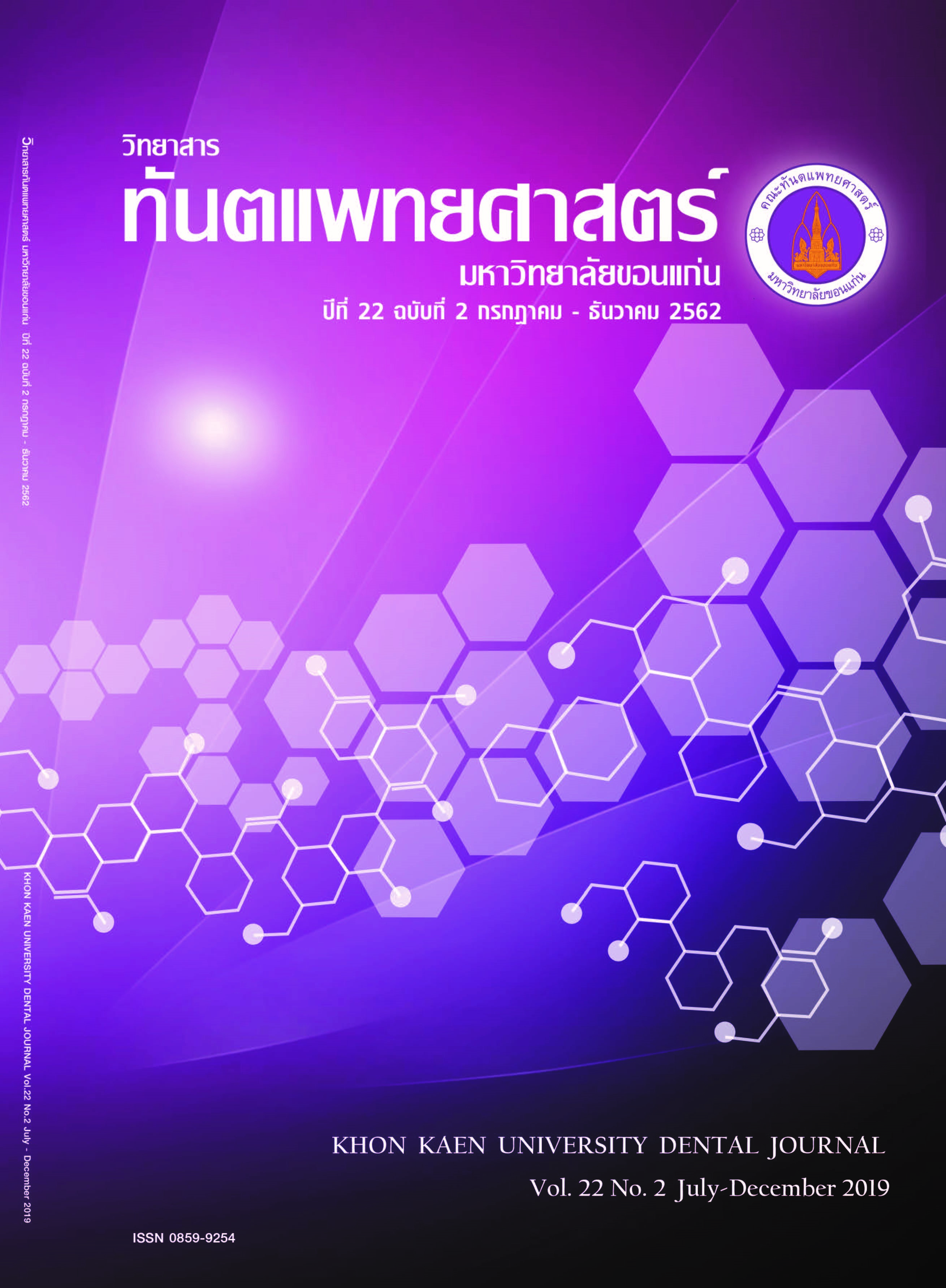Evaluation of the Survey Line Validity and Satisfaction When Using the Intraoral Surveyor Model II on the Customized Model
Main Article Content
Abstract
The purpose of this study was to compare the validity of the survey lines on the customized model between the intraoral surveyor model II and the Ney surveyor and satisfaction when using the intraoral surveyor model II on the customized model. Twelve examiners were the first to third year postgraduate students. The result would be considered about (1) evaluation of validity of the survey line by using the Ney surveyor and the intraoral surveyor model II and (2) the satisfaction questionnaire about the use of the intraoral surveyor model II. The difference between the distances of the two survey lines in each customized tooth was measured at the midpoint of two survey lines which was the intersected area between the lines and groove by using the stereo microscope with X30 magnification. Four customized models with four customized teeth, which were the measuring teeth, included upper right first premolar (14), upper right second molar (17), upper left second molar (27), and upper left canine (23), were sandblasted with aluminium oxide (Al2O3) to create the surface roughness. Then groove was created at midbuccal surface of upper left canine, proximal surface of upper right first premolar, upper right second molar and upper left second molar. Two color pencil leads including black and red colors, were used between two types of surveyor.
The results showed that most of examiners had mean difference between the distances of two survey lines higher than the control group (0.045 ± 0.026 millimeters). The two one-sided test (TOST) at the acceptance criterion was 0.026. The confidence interval of four examiners, was about 33.3%, contained completely in the equivalence interval. That meant four examiners had validity of the survey line of the intraoral surveyor model II. The results of the satisfaction questionnaire represented that almost examiners satisfied both of use and design of the intraoral surveyor model II in high level. Suggestion in part of use, as surveying in the posterior teeth, was at moderate level. And suggestion in part of design, was height of the surveying rod, was at moderate level. It can be concluded that the intraoral surveyor model II can be used to evaluate guiding plane or path of placement and removal of the prosthesis and transferred to the patient’s mouth if it develops following the suggestions. Moreover, the examiner should be familiar with the device when using.
Article Details
บทความ ข้อมูล เนื้อหา รูปภาพ ฯลฯ ที่ได้รับการลงตีพิมพ์ในวิทยาสารทันตแพทยศาสตร์ มหาวิทยาลัยขอนแก่นถือเป็นลิขสิทธิ์เฉพาะของคณะทันตแพทยศาสตร์ มหาวิทยาลัยขอนแก่น หากบุคคลหรือหน่วยงานใดต้องการนำทั้งหมดหรือส่วนหนึ่งส่วนใดไปเผยแพร่ต่อหรือเพื่อกระทำการใด ๆ จะต้องได้รับอนุญาตเป็นลายลักษณ์อักษร จากคณะทันตแพทยศาสตร์ มหาวิทยาลัยขอนแก่นก่อนเท่านั้น
References
2. Carr AB, Brown DT. Direct Retainers. In: Dolan J, Sprehe C, editors. McCracken's removable partial prosthodontics. 12th ed. St. Louis, Mo: Elsevier Mosby;2011.67-95.
3. Roland W, Charles J, Ralph W. Surveyor. Johnston's Modern Practice in Fixed Prosthodontics. 4th ed. Philadelphia, PA: W B Saunders Co;1986.402-8.
4. Limentani GB, Ringo MC, Ye F, Berquist ML, McSorley EO. Beyond the t-test: statistical equivalence testing. Analytical chemistry 2005;77(11):221A-6A.
5. Sakornram R, Aerarunchot S, Prunkngarmpun C, Puasiri S. A comparison of the survey line validity between the intraoral surveyor model II and the Ney surveyor on the customized model, [dissertation]: Khon Kean University;2018.
6. Sinjaru T. Research and Statistical Data Analysis through SPSS. 9th ed. Bangkok: Business R&D;2008.
7. Gold HO. Instrumentation for solving abutment parallelism problems in fixed prosthodontics. J Prosthet Dent 1985;53(2):172-9.
8. Goransson P, Parmlid A. A new paralleling instrument, Paramax II, and the Kodex drills. J Prosthet Dent 1975;34(1):31-4.
9. Haeberle CB, Abreu A, Metzler K. A Technique to Facilitate Tooth Modification for Removable Partial Denture Prosthesis Guide Planes. J Prosthet Dent 2016;25(5):414-7.
10. Ivanhoe JR, Koka S. Intraoral recontouring aid. J Prosthet Dent 1996;75(4):443-5.
11. Kopsiaftis CP. An intraoral paralleling instrument. J Prosthet Dent 1966;16(5):973-7.
12. McCarthy MF. An intraoral surveyor. J Prosthet Dent 1989;61(4):462-4.
13. Netti CA, Skirvin DR, Phelan PR, Jones TK. A simplified intraoral surveying device. J Prosthet Dent 1992;67(6):870-2.
14. Parmlid A. A new intraoral parallelometer. J Prosthet Dent 1967;18(5):469-75.
15. Patil PG. Modified measuring compass as an intraoral paralleling device. Indian J Dent Res 2010;21(3):452-3.
16. Tangjunyatam W, Mayurasakorn S, Aerarunchot S, Prunkngarmpun C, Suksantisakulchai N. A comparison of the validity between the intraoral surveyor and the Ney surveyor on survey line-customized model [dissertation]: Khon Kean University;2014.
17. Vitsentzos SI. A new device to directly examine parallelism of abutment teeth. J Prosthet Dent 1989;61(5):531-4.


